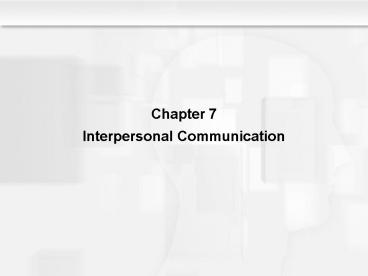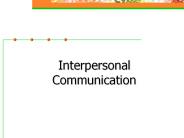Interpersonal Communication - PowerPoint PPT Presentation
1 / 34
Title:
Interpersonal Communication
Description:
It conveys emotions; facial expressions and body posture can convey how we feel without words. ... multichanneled: we use facial expressions, gestures, eye ... – PowerPoint PPT presentation
Number of Views:213
Avg rating:3.0/5.0
Title: Interpersonal Communication
1
- Chapter 7
- Interpersonal Communication
2
The Process of Interpersonal Communication
- Interpersonal communication is an interactional
process in which one person sends a message to
another. - It involves at least two people.
- It is a process involving a series of actions.
- It is not one-way, but bi-directional.
3
Technology and Interpersonal Communication
- Electronically mediated communication is
interpersonal communication that takes places via
technology. - Although technology offers convenience, there are
some disadvantages - Overlap between work and home.
- Intrusion of private conversations into public
spaces. - Absence of non-verbal cues that convey meaning in
face-to-face interactions.
4
Communication and Adjustment
- Effective communication is essential for many
important aspects of life. - Good communication enhances satisfaction in
relationships. - Poor communication is a major cause of
relationship break-ups.
5
Nonverbal Communication
- Nonverbal communication is the transmission of
meaning from one person to another through means
or symbols other than words. - A great deal of information is conveyed in this
manner, so it is important to recognize the
general principles of nonverbal communication.
6
Nonverbal Communication, continued
- General principles of nonverbal communication.
- It conveys emotions facial expressions and body
posture can convey how we feel without words. - It is multichanneled we use facial expressions,
gestures, eye contact, vocal tone and body
language. - It is ambiguous can be difficult to interpret.
- It may contradict verbal messages
- It is culture-bound nonverbal signals vary from
one culture to another.
7
Elements of Nonverbal Communication
- Personal space
- Proxemics - is the study of personal space
- Personal space is a zone of space surrounding
a person that is felt to belong to that
person. - Preference for amount of personal space depends
on - Culture (see Figure 7.4).
- Status of the individuals involved.
- How well you know the person.
8
- Figure 7.4. Interpersonal distance zones.
According to Edward Hall (1996), people like to
keep a certain amount of distance between
themselves and others. The distance that makes
one feel comfortable depends on whom one is
interacting with and the nature of the situation.
9
Elements, continued
- Facial expression
- Facial expressions convey basic emotions,
recognized by people around the world. - However, there are culture-specific norms, called
display rules, that govern the expression of
emotion. - There are also gender differences in expression
of emotion, with most males showing less
expression than do females.
10
Elements, continued
- Eye contact
- Duration of eye contact is the most meaningful
aspect of this channel of nonverbal
communication. - Among European Americans, high levels of eye
contact are associated with effective social
skills and credibility. - However, eye contact is judged as offensive by
other cultures (e.g., Native American tribes).
11
Elements, continued
- Eye contact, continued
- Eye contact also conveys intensity of feelings.
- In a positive context (e.g., romantic partners)
long gazes signal loving feelings, but - In a negative context (e.g., road rage) long
gazes are interpreted as stares, and they make
people uncomfortable. - Visual dominance seems to be more a function of
status than of gender
12
Elements, continued
- Body language
- Kinesics is the study of communication through
body movements. - An open posture (e.g., arms uncrossed and down
at sides) conveys a relaxed state, whereas - A closed posture (arms crossed) conveys
defensiveness or tension. - Finally, hand gestures emphasize the words we
speak.
13
Elements, continued
- Touch
- Where and whom we touch conveys a variety of
meanings, especially status and power. - There are strong norms that govern where we touch
friends. - Female-female pairs touch more often than do
male-male pairs. - Cross-gender touch is interpreted as support by
females, but as power or sexual interest by males.
14
Elements, continued
- Paralanguage
- Paralanguage refers to how something is said
rather than to what is said. - Variations in vocal emphasis can give different
meanings to the same words. - Variations in speech also convey emotions (e.g.,
rapid speech indicates anxiety or excitement).
15
Elements, continued
- Detecting Deception
- Nonverbal cues that actually indicate deception
are often different from those most people
believe indicate deception (see Figure 7.8). - For example
- Liars often say less, not more.
- Liars are not necessarily good storytellers and
include less unusual content in stories. - Liars are more tense and make a more negative
impression on the listener.
16
- Figure 7.8. Detecting deception from nonverbal
behaviors. This chart summarizes evidence on
which nonverbal cues are actually associated with
deception and which are believed to be a sign of
deception, based on a research review by DePaulo,
Stone, and Lassiter (1985).
17
The Significance of Nonverbal Communication
- Nonverbal sensitivity is the ability to
accurately encode (express) and decode
(understand) nonverbal cues. - Woman tend to be better encoders and decoders.
- However, this may stem from higher motivation.
- Thus, anyone can improve their nonverbal skills.
18
Toward More Effective Communication
- Tips for creating a positive interpersonal
climate - Learn to feel and communicate empathy.
- Practice withholding judgment.
- Strive for honesty.
- Approach others as equals.
- Express your opinions tentatively.
19
More Effective Communication, continued
- Self-Disclosure the act of sharing information
about yourself with another person is
important to adjustment for several reasons. - Sharing problems with others plays a key role in
mental health. - Emotional self-disclosures lead to feelings of
closeness. - Self-disclosure in romantic relationships is
associated with relationship satisfaction.
20
More Effective Communication, continued
- Self-disclosure, continued
- Reducing the risks of self disclosure.
- Disclose information to others gradually.
- Dont disclose more than the other is willing to
disclose. - Watch for nonverbal stop cues from others.
- Be aware of risks associated with electronic
disclosures.
21
More Effective Communication, continued
- Self-disclosure, continued
- Self-disclosure and relationship development.
- Self-disclosure varies over the course of
relationships. - At the beginning, there are high levels of mutual
self-disclosure, which taper off as the
relationship becomes established. - In established relationships, disclosures are not
necessarily reciprocated.
22
More Effective Communication, continued
- Relationship development, continued
- Movement away from reciprocal self-disclosures in
established relationships occurs for two reasons - There is more of a need for support than a
reciprocal disclosure from the other person. - The need for privacy outweighs the need for
mutual self-disclosure.
23
More Effective Communication, continued
- Self-disclosure, continued
- Culture, gender, and self-disclosure.
- Personal self-disclosures occur more in
individualistic cultures, whereas disclosures
about ones group membership are the norm in
collectivist cultures. - Females tend to disclose more than do males, and
this trend is strongest within same-gender
friendships.
24
More Effective Communication, continued
- Tips for Effective Listening.
- Signal your interest in the speaker by using
nonverbal cues - Face the speaker squarely.
- Lean toward them.
- Try not to cross arms and legs.
- Maintain eye contact.
25
More Effective Communication, continued
- Tips for Effective Listening, continued
- Hear the other person out before you respond.
- Engage in active listening by
- Asking for clarification if information is
ambiguous. - Paraphrasing what the person said by stating the
speakers main points back to them to ensure you
have interpreted correctly. - Pay attention to the others nonverbal cues.
26
Communication Problems
- Communication apprehension or anxiety caused
by having to talk with others is usually
followed by one of four responses - Avoidance choosing not to participate.
- Withdrawal clamming up in conversation you
cannot escape. - Disruption the inability to make fluent
statements. - Overcommunication (e.g., nervous speech).
27
Communication Problems, continued
- Barriers to effective communication.
- Defensiveness excessive concern with
protecting oneself from being hurt. - Motivational distortion hearing what you want
to hear. - Self-preoccupation being so self-absorbed the
other person cannot equally participate. - Game playing manipulating the interaction, or
concealing your real motives for a selfish
purpose.
28
Interpersonal Conflict
- Beliefs about conflict.
- Most people believe any kind of conflict is bad.
- However, avoiding conflict is usually
counter-productive and leads to a
self-perpetuating cycle (see Figure 7.11). - It is better to confront conflicts constructively
so that issues can be aired and resolved.
29
- Figure 7.11. The conflict avoidance cycle.
Avoiding conflict can lead to a self-perpetuating
cycle (1) people think of conflict as bad, (2)
they get nervous about a conflict they are
experiencing, (3) they avoid the conflict as long
as possible, (4) the conflict gets out of control
and must be confronted, and (5) they handle the
confrontation badly. In turn, this negative
experience sets the stage for avoiding conflict
the next timeusually with the same negative
outcome. (Adapted from Lulofs, 1994)
30
Interpersonal Conflict, continued
- Five Types of Conflict
- Pseudoconflict false conflict from game
playing. - Fact-based conflict disagreement about factual
issues. - Policy conflict disagreement about how to
handle a situation. - Value-based conflict disagreement that occurs
when people hold opposing values. - Ego-based conflict emphasis on winning over
resolving the conflict.
31
Interpersonal Conflict, continued
- Styles of managing conflict
- Two dimensions (concern for self, and concern for
others) underlie five distinct patterns of
managing conflict (see Figure 7.12). - Avoiding/Withdrawing (low concern for self and
others). - Accommodating (low concern for self, high concern
for others). - Competing/Forcing (high concern for self, low
concern for others).
32
- Figure 7.12. Five styles of handling
interpersonal conflict. In dealing with discord,
individuals typically prefer one of five styles.
The two dimensions of concern for self and
concern for others underlie each of the five
styles.
33
Interpersonal Conflict, continued
- Styles of Managing Conflict, continued
- Compromising (moderate concern for self and
others). - Collaborating (high concern for self and others).
- While compromising simply involves splitting the
difference, collaborating involves finding a
solution that is maximally satisfying to both
parties.
34
Interpersonal Conflict, continued
- Dealing Constructively with Conflict
- Make communication honest and open.
- Use specific behavior to describe another
persons annoying habits rather than general
statements about their personality. - Avoid loaded words.
- Use a positive approach and help the other person
save face. - Limit complaints to the current situation.
- Assume responsibility for your own feelings and
preferences.































